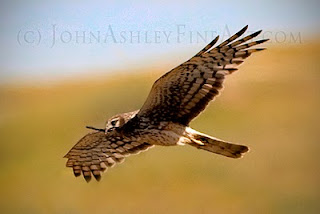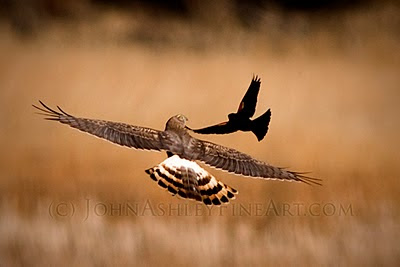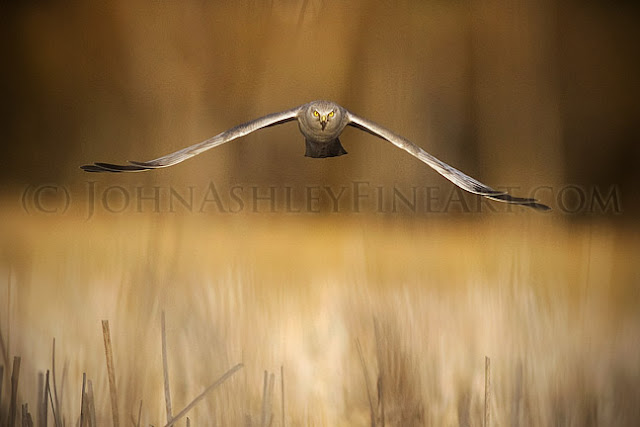 |
| A female Harrier carries a stick to add to her nest. |
What begins as a hissing lump of feathers will grow up to become one of our most beautiful and graceful birds. An adult Harrier sports a wingspan between 42-48" wide, but they only weigh in at 0.5 to 1.3 pounds. That's about a four-foot-wide wing weighing one pound! Such a high surface-area-to-weight ratio makes for one very manuverable and fast bird. Male Harriers have been seen overtaking Prairie Falcons in flight.
Harriers are not owls, but they do have owl-like, feathered facial discs to direct sound into their ears. So like owls, Harriers hunt by sound as well as by sight. They'll fly low across the meadow, in a gracefully lilting glide, watching and listening for small critters (primarily voles) hidden in the grass below. With a quick flip of their long tail, they change direction instantly and dive on their prey.
Harriers are ground nesters, and the cryptic brown female takes over and finishes construction after the male starts the nest. The light-gray male seldom comes to the nest after incubation starts. While she incubates their eggs, he handles the hunting and makes food deliveries to his mate. He flies in with a meal, calls out to her, and she flies up from the nest to make the food exchange in mid-air. About two weeks after the chicks hatch, the female starts hunting again. After the dark brown youngsters become profecient at flying, mom will make mid-air food exchanges with them as well.
 |
| A female Northern Harrier gets mobbed by a Red-winged Blackbird. |
Harriers are occsionally polygynous (when food is plentiful), with one male mating with 1-5 females and delivering food to all of them while nesting. They'll sometimes nest in loose colonies of 10-20 individuals. Adults are not territorial, but they will aggressively defend the nest from predators (and photographers). During winter the females will aggressively exclude males from prime feeding areas, but then they'll roost communally on the ground each night.
The Harrier population is gradually declining globally, but in North America it appears to be stable. Most of Montana's Harriers are migratory, arriving here in March or April and then heading back south by late November.


